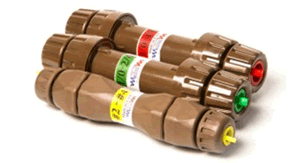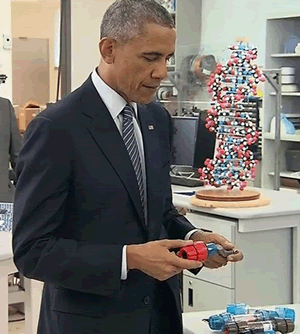Melni Connectors Jumps into the Shark Tank
Idaho-based Melni Connectors was started by an inventor who designed a connector based on a children’s toy. Last week he found himself on the television hit Shark Tank, pitching the idea to potential investors.

Inventor and company founder Mark Melni with his CFO Armand Eckert
Inventor Mark Melni didn’t know a children’s toy would leave him swimming with the sharks.
Although the connector industry is dominated by a handful of big-name corporations that offer long rosters of legacy and commodity components, Melni Connectors and its innovative electrical connector just proved there are still opportunities for entrepreneurs and start-ups in the industry.
Ancient Chinese Secrets?
Melni, founder of his eponymous connector company based in Twin Falls, Idaho, was inspired by the Chinese finger trap design, best known as the children’s practical joke in which the player tries to remove his fingers from inside a woven bamboo cylinder. The trick is that most try to pull their fingers out of the tube, which only tightens the cylinder so they remain locked in; the secret is to push the fingers toward the center of the tube to loosen the openings and release the fingers.
The actual origin of the puzzle (also called finger cuffs) is murky at best. Stories abound on the Internet that the tube was used as a test of intelligence in Imperial China; that Lao Tzu used the design to trick his enemies; or that it’s a more recent invention by a Victorian toy salesman.
But there’s no doubt the design could revolutionize electrical connectors, which is what the producers of ABC’s Shark Tank thought when they invited Mark Melni to compete on the show this past Friday night. Shark Tank, an American reality television program in which entrepreneurs pitch their ideas to a panel of successful potential investors, has awarded more than $45 million dollars to fund creative ideas during its first five seasons. Melni’s team went on the show to ask for a $500,000 investment in return for 5% equity in the company.
Faster, Easier Splicing for Electricians
 Melni invented the splice connector in his garage in the summer of 2007 based on the simple finger trap principle, after watching his staff at Microchips Etc struggle to crimp wires in the usual way.
Melni invented the splice connector in his garage in the summer of 2007 based on the simple finger trap principle, after watching his staff at Microchips Etc struggle to crimp wires in the usual way.
“I conceived the spiral concept using a lug type of connector,” said Melni. “Then I started to think of ways to use this design in other connectors. Crimp connectors are now and always will be a PIA (editor’s note: pain in the—well, you know). A good friend of mine put together a large clock for the local YMCA and after connecting 200 crimps, he couldn’t shake my hand! His hand was completely stiff from all the work.”
According to Melni, splice crimping for large-gauge wires has plagued electricians for decades. Traditionally, to join two large conductors together, an electrician would insert the wire into an aluminum sleeve and manually crimp it down in multiple places. Once secured, the wire and crimp requires a sleeve for environmental sealing. This process is not only time-consuming and physically challenging for the electrician, but it also requires the use of large and expensive tools.
With Mark Melni’s patented design, you simply insert the conductors and twist the caps with a pair of pliers. The entire process takes less than a minute, requires no special tools, and can easily be installed in spaces that traditional crimps can’t reach.
“Electricians would benefit greatly from using a Melni Connector,” said Paul Melni, production manager, Melni Connectors (and son of the inventor). “It would save them time and physical toll on their bodies.”
An ergonomics analysis was performed on the connector and concluded “the Melni connector splice method has significant ergonomic benefit over the traditional method of performing splices…the Melni method should replace the traditional method whenever feasible.”
Swimming with the Sharks
The innovative and game-changing design seemed like a perfect fit for Shark Tank. Mark Melni contacted producers three years ago via email, and in March 2014, he received a call. They asked him to fill out a 30-page questionnaire and produce a 10-minute video that described the invention and showcased the company’s personalities.
“That was the most difficult part of the application process,” he said. “The last time I had to write that much information was in high school! And our video couldn’t be technical—it had to be pretty goofy. Luckily, Armand and I do goofy really well.”
Armand Eckert, Melni’s CFO and a local farmer, personally invested in the company a few years ago. He joined the company last year to help set up the manufacturing arm of the business.
Once they were chosen to appear on the show, producers wanted to cut Byron Dunn, an investor in Melni and a 30-year lineman, from the pitch (presumably to streamline the segment for time), but Melni stood his ground. “I explained that without him, no one would understand what my invention was all about. I think the producers realized the potential in my product to be disruptive.”
As it turned out, Dunn became the star of the pitch. Dressed in his lineman gear and hard hat, he demonstrated both the traditional way of crimping and the new, improved method via the Melni connector. The investors, who could see the benefits of the product to a lineman, were impressed when Dunn told them he’d invested $50K of his own money upon first view of the connector, without asking the valuation of the company.
“It took me five minutes to figure out how it works and as a lineman, I wanted in,” Dunn told the panel.
But the judges didn’t understand the breadth of product applications or how to get the product into the marketplace, and were particularly skeptical that Melni could value the company at $10 million.
One by one, the sharks passed on the investment opportunity, even though Eckert said Melni expects $6 million in sales next year and $18 million after that.
It came down to the last shark, Mark Cuban, the successful entrepreneur and investor who founded HDNet, Broadcast.com, and MicroSolutions, who’d said little during the pitch. After noting that no one understood his first entrepreneurial idea yet still funded him for fear of missing out on something big, he offered Melni $500,000 for a 12% interest in the company, with an option to invest another $1 million later on and up his equity to 15%.
After a tense moment of hesitation, Melni accepted the offer. Cuban congratulated his new business partners and said, “Now, let’s go make whatever that is.”
Game Changer
It looks like Mark Melni’s game changer for the connector industry could be a game changer for his own company.
“Producers of Shark Tank have told us to expect the ‘Shark Tank effect’ to happen quickly after airing,” he said. “In preparation we have built an infrastructure that will hopefully be able to handle the large influx of orders and customers. By next year, Melni Connectors will be in a new facility and have a larger staff. Currently the only in-house process is assembly and fulfillment. As the orders get larger, we hope to bring some of these processes on site.”

President Obama took a tour of Tech Help at Boise State University, which helped Melni create the first prototypes of the connector. The Melni Battery Terminal Connector, which was on display, sparked the president’s interest.
Mark Melni is back to work on his next invention, a system for connecting rebar instantly. But that’s the future, and right now the company is focused on bringing the splice connector to market in a big way, thanks to Mark Cuban.
Despite all the excitement surrounding its success on the show, the Melni team is most proud to have designed an innovative connector that will make a lineman’s job easier.
As they left the boardroom at the end of the Shark Tank segment, Melni patted Dunn on the back, and Dunn said to no one in particular, “I’m not really sure what just happened…but I know that connector is good and linemen are going to like it, so I’m just very happy.”

